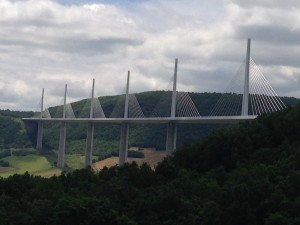Six months ago, I had never heard of Clermont-Ferrand. Which probably left me in the overwhelming majority of people living in Europe.
But the notion of it began to grow on me, and today we spent six hours in a car to drive the 190 miles or so to Clermont-Ferrand and back.
Our first major road trip, since we arrived in France.
What prompted the visit?
–When coming from the east (Montpellier, that is) to get to where we live, in the Languedoc, you probably will travel on the 750 freeway, which ends with a curious distinction. You can go south, toward Clermont, or north toward Clermont. The difference (Clermont-Herault versus Clermond-Ferrand) is just subtle enough to lure X percent of commuters into choosing the wrong direction.
–Clermont-Ferrard is unusually cold and gloomy, by French standards. When we watch the national weather report here (known as meteo), the TV stations typically throw highs and lows on a map of France … and it is astonishing how often Clermont-Ferrand, a city slightly south of dead center of France, will have the coldest night and the least-warm day.
–Clermont-Ferrand is the corporate headquarters of Michelin, one of the most famous tire companies — and mapmakers — in the world.
–The city is near a place called Gergovie, where the ancient Gauls inflicted a minor defeat on a Roman army led by Julius Caesar, back when the Romans (and especially Julius Caesar) rarely lost to anyone.
–The city is the capital of the Auvergne, which is located on the Massif Central, a somewhat high plateau (like, 2,500 feet) and the most significant geographical formation in France, one that has pushed the country’s population centers into a ring-shaped path around the massif.
–And Clermont-Ferrand seems fairly comfortably being the most remote as well as most anonymous major city (in the country’s top 25, in population) in France. Nothing is near it, and generally you have to want to get there to end up there.
Which is what we did.
It was fun, on several levels.
–The drive up the A75 motorway is pretty much three hours of pure scenery. One of those “look at that … oh, look at that” journeys. More interesting than driving to what would be a big American city not really close to another significant population center. Denver, for example. Salt Lake City.
–It was cool to be near the site of a battle Julius Caesar lost. The Gauls, led by a chieftain named Vercingetorix, won the Battle of Gergovie — though Caesar soon bounced back and overwhelmed Vercingetorix and his tribesmen in the famous Battle of Alesia. (The French still venerate Vercingetorix as a sort of first-century-BC freedom fighter, and he is an inspiration for the Asterix comic-book franchise.)
Clermont-Ferrand, naturally, has an equestrian statue (above) honoring the local hero, Vercingetorix, in the sprawling Place de Jaude. (Things did not end well for the Gaulish chieftain; he was held in a Roman prison for six years before he was strangled, following Caesar’s victory parade.)
–The Massif Central exists — and tends to push travelers around it, rather than draw them through it — because of prehistoric volcanic activity. That has produced a city, in Clermont-Ferrand, mostly built with local rock — which is the black of volcanic material. So that’s not just air pollution that has colored the old church black — the rock is black, and it’s a curious sight.
–The A75 motorway was completed only six years ago, and it has that new-freeway look to it, still, including the remarkable Millau Viadict, the world’s tallest bridge (below). Overall, lots of curves, because of all the hills. And very few populated places. Which is probably why a lot of French have never been to Clermont-Ferrand or even the Massif Central.
–Clermont-Ferrand was the hometown of Blaise Pascal, a prominent mathematician and physicist, who lived in the 17th century.
It was a worthwhile adventure.
Clermont-Ferrand suffered, economically, when Michelin moved most of its tire-making out of the city, but it seems to have rebounded of late, with an emphasis on high-tech companies.
The city seems clean, tidy, orderly and picturesque. It has an imposing opera house, for a city of about 140,000 (24th-biggest in France).
In our few hours in the city, we had lunch on a terrace at the Place de Jaude and listened to an organ recital at the nearby cathedral. People looked content, and not at all depressed that their city is one of the few that is often gray and cool, in the southern half of the country.
Oh, and about the weather there. The issue is … the nearby extinct volcanoes (the Chaine de Puys) which create a “rain shadow” over Clermont-Ferrand, therefore giving it a climate that is more continental (long, cold winters; short, hot summers) than is found in the rest of France.
Average high temperature, year-round, is 62.2 Fahrenheit, and average low is 43.9. Paris, which is about 200 miles north of Clermont-Ferrand, has an average yearly low of only 47.3.
I don’t imagine we will go back, but it’s nice to say we were there … often the chilliest place in France.



1 response so far ↓
1 David // Jun 14, 2016 at 4:08 PM
Fascinating. I was familiar with the name Clermont-Ferrand, having followed Formula 1 racing as a kid (the French Grand Prix was held at a nearby track four times), but didn’t know any of the rest of it. This is why I enjoy your blog so much.
Leave a Comment